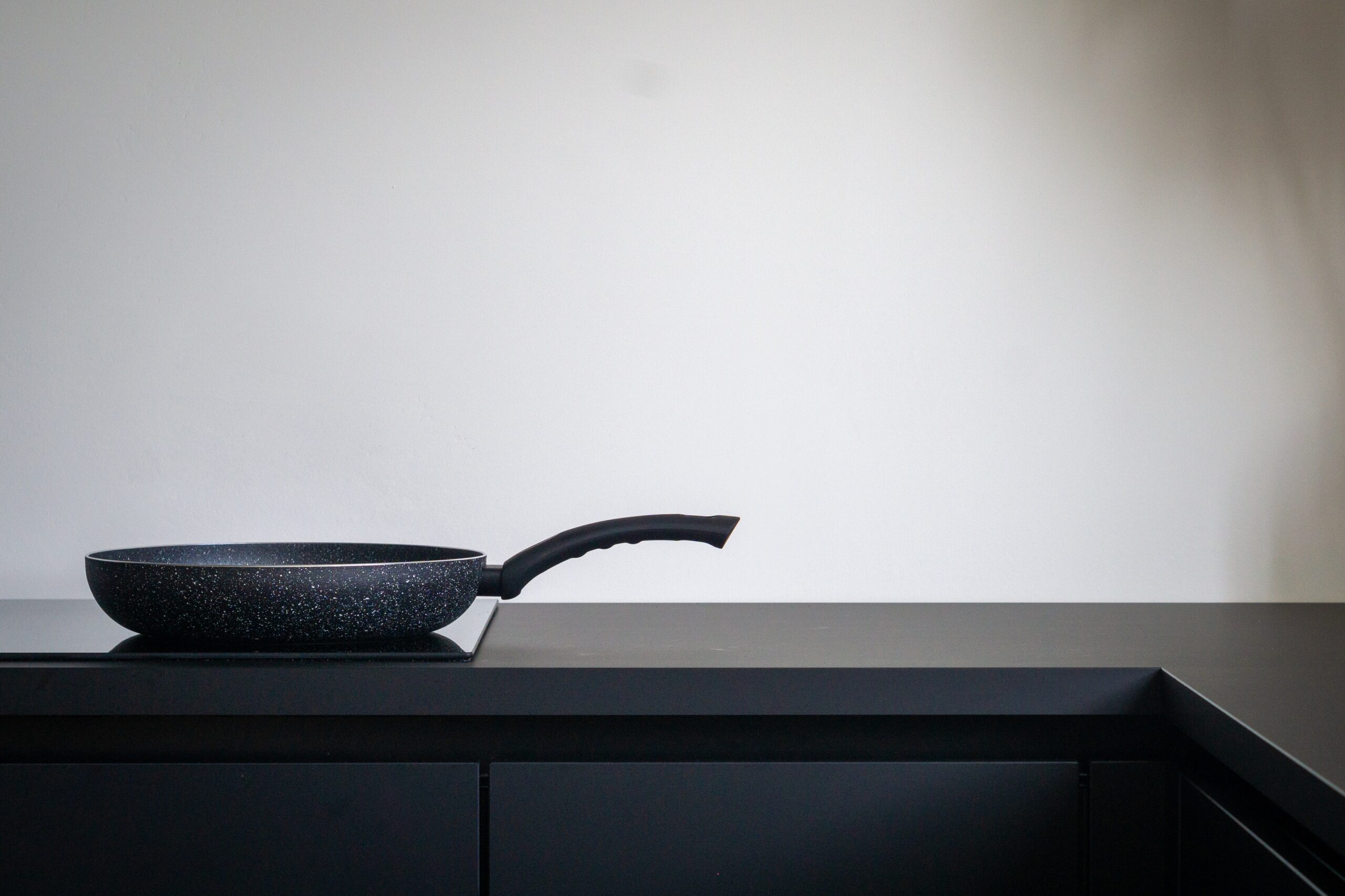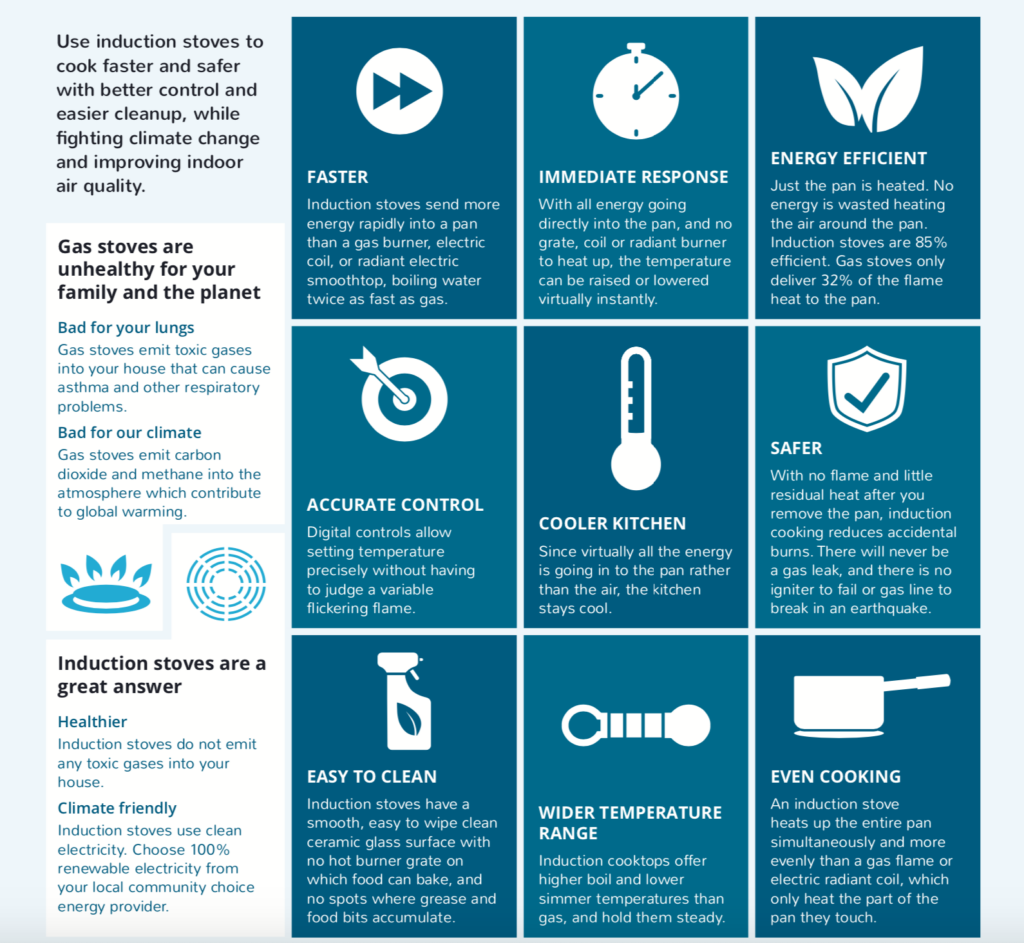 This blog has been updated on 10/4/23
This blog has been updated on 10/4/23
Electrifying Berkeley homes is the next step to eliminating one of our largest sources of greenhouse gasses and becoming the sustainable hub we aim to be. Shifting to using electric vehicles, heat pumps, electric heating, and induction cooking, are some of the ways we can get started. Making all of these changes can be daunting, and it can be hard to make the right choice. Luckily, Acterra and East Bay Community Energy have teamed up to help people test out electrifying their kitchens by lending out Induction Cooking kits to help people decide if induction cooking is right for them with Ecology Center being one of the host sites! Now some of you may be wondering what Induction Cooking is all about, so we’ve provided some answers for Frequently Asked Questions below, with the help of our Berkeley Climate Action Coalition Electrification Working Group.
How Does Induction Cooking Work?
Under the ceramic glass surface of an induction cooktop is a coil of copper. When you turn on the power, an alternating electric current flows through the coil and produces an invisible magnetic field. The magnetic field causes the iron molecules in the cookware to move and bump into each other, which generates heat. The heated metal pan then conducts heat to the food or water inside it. The ceramic glass surface remains cool, or slightly warm from contact with the hot pan. To learn more, check out our Induction Stoves & Cooktops Factsheet.
What Are the Benefits of Induction Cooking?
Induction’s high efficiency means less time and energy for your cooking. At 85% efficiency, induction cooktops use significantly less energy to heat up food compared to gas stoves’ 36% efficiency. In a study conducted by Frontier Energy, induction cooktops outperformed gas burners in heat time, taking less than half the time to boil the same amount of water. Plus, since induction is able to achieve high efficiency by heating only the cookware instead of emitting a flame, you can expect a cooler kitchen when cooking with induction on hot summer days. Even when compared to traditional electric coil stoves, which are also a great way to get methane out of your home, induction is slightly more energy efficient. Induction’s selling point is its performance; unlike traditional electric, induction maintains efficiency even when heating large volumes.

Chart Comparing Efficiency of Types of Cooktops. Chart from Frontier Energy Residential Cooktop Performance and Energy
Comparison Study, July 2019
Not only is induction more efficient, but it also reduces in-home air quality risks making induction the safest option for your home. Burning natural gas indoors releases dangerous air pollutants, such as nitrogen oxide, benzene, and methane. As one of the forms of gas that contribute to smog, nitrogen oxide is dangerous to human health. This harm is exacerbated without proper ventilation, like a range hood. Unfortunately, a 2022 Stanford University study found that gas stoves also leak methane and other indoor air pollutants even when they are not on. The impacts of these pollutants in the home are well-documented. A study conducted by the Rocky Mountain Institute found that “children in homes with gas stoves have a 42 percent increased risk of experiencing asthma symptoms, a 24 percent increased risk of ever being diagnosed with asthma, and an overall 32 percent increased risk of both current and lifetime asthma.”
If efficiency and safety have not already sold you, another major benefit to induction cooking is that it contributes fewer greenhouse gas emissions to the atmosphere than gas cooking. A study conducted by the Green Energy Strategy Institute in South Korea found that a housing complex using induction cooktops emitted 2.6 times less emissions than households using gas stoves. In California, because of community choice aggregates like East Bay Community Energy and MCE, many households have a choice to opt for a 100% renewable energy mix of wind and solar. Cooking electric with a clean energy mix means that you do not have to worry about emissions associated with energy production.
Check out our factsheet for more information.
How Do I Get Started?
If you’re interested in induction cooking, consider these next steps (more information here):
- Buy a low-cost portable induction hotplate to try out as an alternative to your gas stove.
- Anyone living in East Bay Community Energy’s service area (all of Alameda County except Alameda) can sign up for our program. Apply here.
- Berkeley Public Library users could also rent a cooktop through the Berkeley Tool Library.
- Residents outside of Alameda County can utilize a similar program through PG&E.
- Berkeley Public Library users could also rent a cooktop through the Berkeley Tool Library.
- The City of Albany is running an induction cooktop lending program for residents
Where can I find an Induction range or cooktop for purchase?
- Check to see if you are eligible for electrification rebates with The Switch is On
- Check out our guide to Induction Range and Cooktop manufacturers in the East Bay.
- Visit an appliance showroom or test kitchen to view or test drive induction cooktops
- Check out Consumer Reports induction range comparisons or read reviews of induction ranges and cooktops on appliance dealers’ websites.
- Talk to people who own induction ranges about their experience





Please add a guide to induction cooking temperatures. A simple table with suggested temperature ranges for different kinds of cooking – sauteing fresh vegetables, braising fish, scrambling or frying eggs, boiling water, etc.